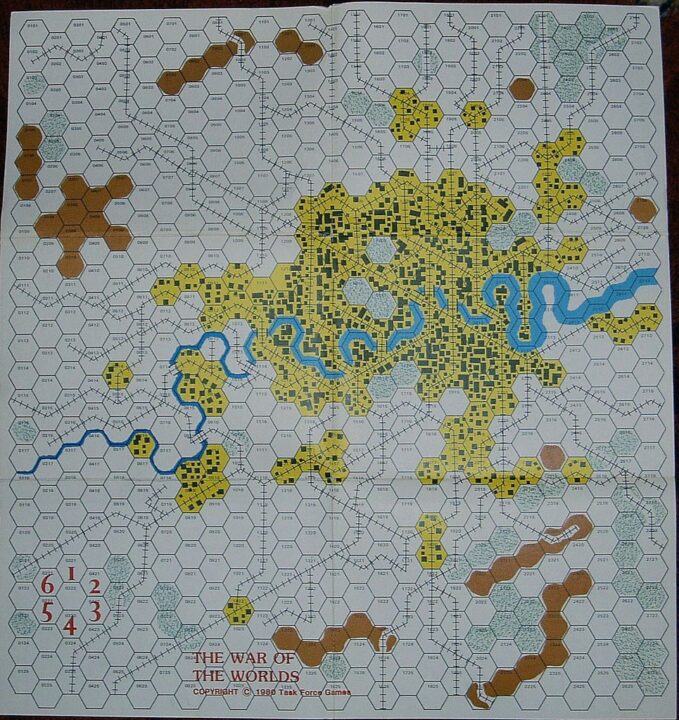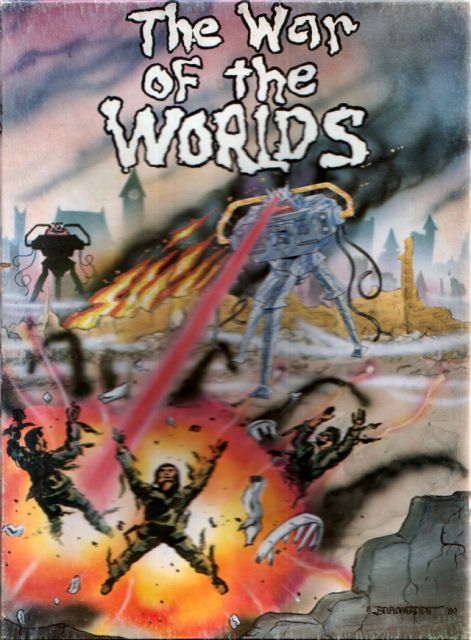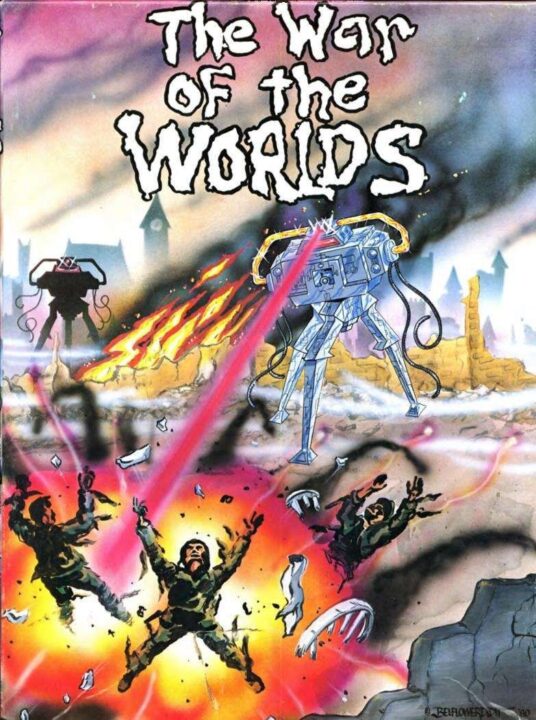Welcome, fellow board game enthusiasts! Today, we’re diving into a review of the classic sci-fi invasion game, The War of the Worlds. Prepare for an interstellar journey as we break down its gameplay mechanics, balance, theme, immersion, component quality, and replayability. My friends and I spent many game nights battling Martians and defending Earth, and now we’re ready to share our thoughts. Spoiler alert: it’s a wild ride!
How It Plays
Setting Up
First, lay out the game board. Separate the player decks: one for the humans and one for the Martians. Each player picks a side. Place the starting units on the board according to the setup outlined in the rulebook. Don’t forget to shuffle the event cards and place them nearby.
Gameplay
Players take turns drawing cards, moving units, and attacking. The humans try to survive and complete objectives, while the Martians crush everything. Tactical decisions matter a lot. Keep an eye on resources and timing. Use event cards to turn the tide of battle or mess with your opponent’s plans.
Winning the Game
The game ends when one side achieves its objectives. For humans, it’s usually about surviving a set number of rounds or completing specific missions. For Martians, it’s simpler: destroy enough human units or key locations. The side that completes its objectives first wins the game.
Want to know more? Read our extensive strategy guide for The War of the Worlds.
Gameplay Mechanics and Balance in The War of the Worlds
Have you ever tried herding cats? That’s how it felt when I played The War of the Worlds. This game is a head-scratcher, but in the best way possible. The mechanics are simple to understand, yet deviously tricky to master. You have to manage resources, position your units strategically, and anticipate your opponent’s moves. It’s a mental tug-of-war that gets better the more you play.
However, here’s a curveball: the game isn’t entirely fair. Martians have superior strength, while Earthlings rely heavily on resource management and guerrilla tactics. It can sometimes make you feel like you’re fighting an uphill battle if you’re stuck playing the underdog. But hey, no one said saving Earth would be easy, right?
The issue with balance might turn off some seasoned strategy veterans. They’ll feel the Martians have it too easy. That said, the game does offer a chance to switch sides and even the playing field. So, if you’re tired of always being the underdog, you can unleash your inner alien overlord for a change.
What I liked most was how skill significantly affects the outcome. Sure, there’s a bit of luck involved when drawing cards, but your decisions hold a lot of weight. If you lose, you can’t just blame the dice. This makes each victory all the sweeter.
Next up, we’ll zip over to how the theme and immersion add layers to this cosmic clash.

Thematic Depth and Immersion in ‘The War of the Worlds’
Let’s talk theme and immersion, folks! ‘The War of the Worlds’ board game sets itself apart with its rich storyline straight from H.G. Wells’s classic. From the moment you open the box, you can feel the tension between the Martians and the humans. The artwork on the board and cards really pulls you into the 19th-century invasion setting. I mean, those Martian tripods look like they walked straight out of the novel!
While playing, you can’t help but get lost in the narrative. My friends and I often found ourselves talking in character, strategizing like we’re part of the resistance or leading the Martian forces. The game designers did an excellent job incorporating elements of the book into gameplay, making every session feel like a chapter from the story.
However, not everything is rosy in Martian-land. While the theme is engaging, there are moments where the immersion breaks. Some game actions feel a bit too mechanical, pulling you out of the narrative flow. For instance, the resource management aspect, while necessary, sometimes feels more like bookkeeping than battling an alien invasion.
Despite these minor hiccups, ‘The War of the Worlds’ excels at making you feel like you’re part of an epic struggle. If you’re a fan of the book, the game’s thematic elements will resonate with you and add an extra layer of enjoyment.
Now that we’ve explored the theme and immersion, let’s take a closer look at the tangible bits and bobs. Stick around for a deep dive into the game’s component quality!

Component Quality in ‘The War of the Worlds’
Let’s talk about the bits and pieces in The War of the Worlds. First off, the board itself is durable and has a nice, thematic map. It’s sturdy enough to withstand the inevitable drink spills and snack crumbs (which, let’s face it, always happen).
The miniatures are where the game really shines. The alien tripods and human soldiers are beautifully detailed. They almost make the aliens’ impending doom… charming? Well, almost. The cards have a premium feel too, with eye-catching art that’ll make you want to show them off.
However, not everything is peachy. The tokens can be fiddly. It felt like juggling while trying to keep track of resources and damage. A slightly more thoughtful design could have made them easier to manage. Plus, the rulebook could use a bit of polish. It’s clear enough, but a few sections needed a re-read or two, which interrupts the flow of the game.
All in all, the component quality is pretty impressive. I found myself pausing to admire the details between bouts of fighting off Martians. A few tweaks here and there, though, and it could be top-notch.
Ready to hear about how often you’ll yank this game off the shelf? Up next: Replayability and variety!
Replayability and Variety in ‘The War of the Worlds’
‘The War of the Worlds’ isn’t a one-hit wonder. The replayability is strong thanks to its varied strategies and ever-changing board dynamics. You will never have the same game twice, which keeps things fresh and exciting.
Let’s talk about the different ways to play. Whether you like to be aggressive and go full alien invasion, or prefer a more defensive human strategy, this game allows for multiple approaches. The range of tactics is vast, so whether you’re a tactical genius or still trying to figure out what a pincer movement is, you’re good to go.
Variety also comes into play with the different factions. Aliens and Humans play with different rules and units, making each side feel distinct. It’s like playing two different games in one. The asymmetry adds a layer of depth, making each playthrough a unique challenge. You may start rooting for the aliens halfway through, or maybe that’s just me.
Let’s not forget the scenarios. Each scenario adds different objectives and win conditions. This forces you to change your strategy, ensuring you always have something new to chew on. Plus, expansions (if you’re as obsessed as me) bring even more variety.
To wrap it up, ‘The War of the Worlds’ keeps you on your toes with its replayability and variety. Do I recommend it? Absolutely! If you love strategy games that keep you coming back for more, this one’s a no-brainer.
Conclusion
So, there you have it! ‘The War of the Worlds’ is an out-of-this-world experience that balances strategy with a gripping theme. While the Martians may sometimes feel like they have an upper tentacle, the game still offers a high level of replayability and plenty of variety. Its components are mostly top-notch, with only minor hiccups. If you’re a fan of tactical gameplay and can handle a bit of imbalance, this game might just invade your board game nights. Thanks for joining me on this review adventure. Until next time, play more, stress less!


